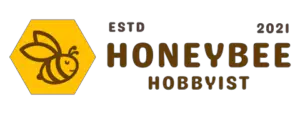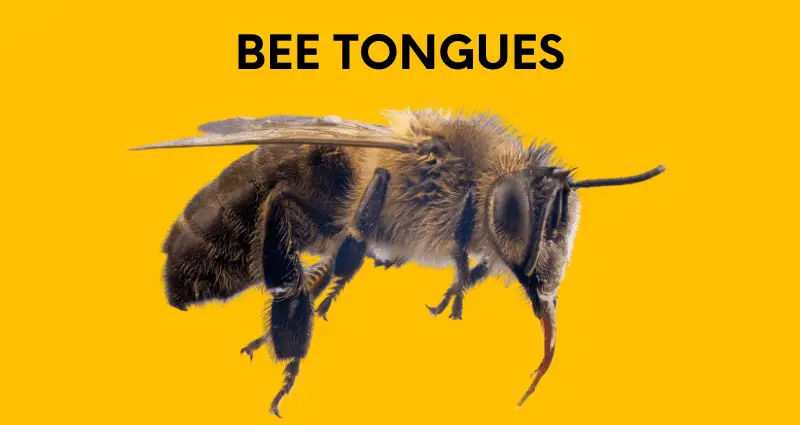Bee tongues come in many shapes and sizes, depending on the species of bee and its purpose in the hive. All bee tongues are highly specialized organ systems composed of various muscles, glands, and sensory organs.
Have you ever wondered how bees feed on the nectar of flowers? Get ready to learn more as you take a fascinating look at the bee tongue and its unique adaptation!
Much research has been done to understand how bees use their tongues for drinking nectar from flowers, but what is certain is that this particular organ is necessary for bees to carry out their pollination duties. So while they may seem small, bee tongues are essential in ensuring healthy ecosystems around us by providing plants with much-needed fertilization services.
Bee Tongue Anatomy
The anatomy of a honey bee tongue (scientifically called proboscis, which is the collection of all of the mouth parts that make the bee tongue function) can be divided into three distinct parts:
- Aapical section (containing the stylet – or needle-like structure)
- Basal section (which is covered in thin hairs)
- Distal section (which holds the mandibles)
The apical section contains several small muscles that work together to extend or retract the tongue when gathering nectar from flowers.
The basal section acts as a scoop with tiny projections or hairs, called papillae, that can extract pollen from each bloom.
Finally, the distal section houses four mandibles that act as scissors that help to cut and manipulate the delicate petals of flowers into shapely little packages for storage within the hive.
To learn more about honeybee anatomy, click here.
Bee Mouth Parts
Bees are one of the oldest and most successful insects, and bee mouth parts are integral to the bee’s survival and ability to pollinate.
The bee tongue is one of the most essential parts of bees. It’s a long, slender appendage with two sets of palps, sensory devices that provide taste and smell sensations.
The bee can extend its tongue when it’s close enough to its food source, an action called “probing.” Additionally, the bee can use its tongue in a whip-like motion or in short bursts to comb flowers for nectar or bits of pollen.
Bees also possess groomed hairs around their face that help them sweep food into their mouths. These hairs allow the bees to gather particles efficiently while they pick up pollen from plants or feed on honey in the hive.
Long-Tongued Bee Families
The fascinating anatomy of bee tongues has been studied for centuries, and more recently, scientists have discovered that some bee families have evolved longer and differently shaped tongues.
This is because primitive flowers were shallower, and the nectar was easily accessible to insects. As flowers evolved, the corolla (petals that enclose the reproductive system) became deeper to protect their nectaries, so certain bee species adapted their tongue length as well.
Some types of long-tongued bees include:
Apidae – The largest family of bees with more than 5,000 species, Apidaes include honey bees, such as the western honey bee (Anthophora affabilis) and bumblebees. Fun fact: bumblebees (Bombus) have the longest tongue of all bees!
Megachilidae – This family of bees includes leaf-cutting bees.
Anthophoridae – Pesky miner bees, carpenter bees, and parasitic bees are in the Anthophoridae family.
Bees with long tongues are typically larger than their shorter-tongued counterparts. They are much more aggressive when defending their food source, proving that these adaptations help them survive better in the wild.
Short-Tongued Bee Families
The short-tongued bees are a fascinating group to study because of their unique adaptation. Short-tongued bees must feed on flowers with shallow-to-medium-depth corollas requiring less effort and energy.
Therefore, those in the short-tongued bee family enjoy more diverse nectar sources.
Some short-tongued bee families include:
Colletidae – Also called plasterer bees, polyester bees, or cellophane bees because of the plastic-like substance used to line their brood cells.
Halictidae – This family includes sweat bees, which have some of the shortest tongues of all bee species.
Andrenidae – This family includes large, ground-burrowing solitary bees, called snowy miner bees (Andrena nivalis).
Frequently Asked Questions
What is a bee tongue?
A bee tongue is a unique organ used to drink nectar, water, and other liquids.
How does the bee tongue work?
The bee tongue works by using capillary action. This means that the tiny hairs on the bee’s tongue create surface tension on the liquid the bee is drinking, which draws the fluid up the tongue and into the bee’s throat.
Why is the bee tongue important?
The bee tongue is essential for the survival of the bee. It is the bee’s primary means of obtaining food and water, and without it, they would not be able to survive. The bee tongue also helps them to pollinate flowers and spread pollen, which is vital for plant reproduction.

